TCT Mobile 114 GSM850/PCS1900 dualband mobile phone User Manual MINI UM USA 30 06 09
TCT Mobile Limited GSM850/PCS1900 dualband mobile phone MINI UM USA 30 06 09
OT 708A UM
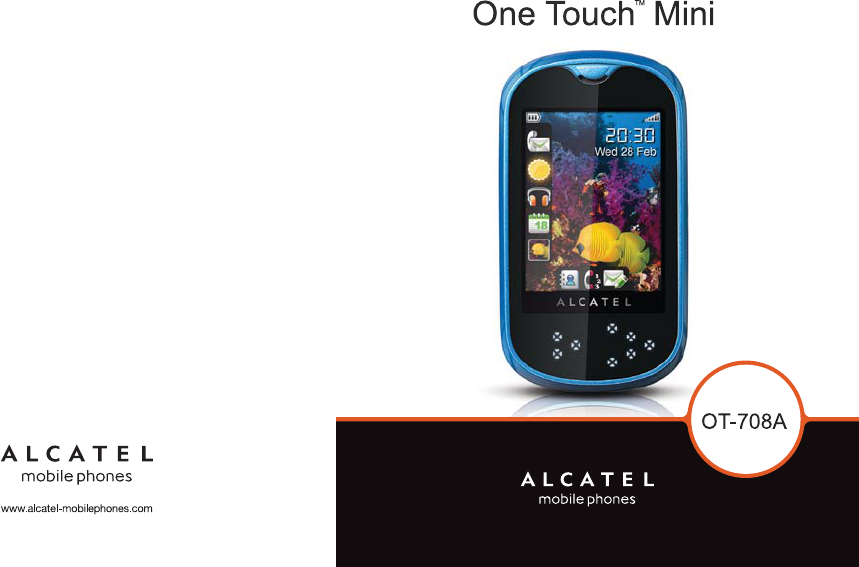

1 2
Introduction ..................................
TCT Mobile Limited would like to thank you for purchasing this cellphone.
Power media applications
- Music player & Radio
- Video
- Webcam
The 1.3 Megapixel camera is the best companion for PC instant messaging.
Bluetooth
With Bluetooth 2.0 supporting A2DP profiles, enjoy handsfree conversations.
Table of contents ..........................
Safety and use ...................................................................6
General information ......................................................11
1 Your telephone ..........................................................13
1.1 Keys&Touch Area .........................................................................................................14
1.2 Main screen icons ........................................................................................................15
2 Getting started ..........................................................17
2.1 Set-up ..............................................................................................................................17
2.2 Power on your phone ................................................................................................19
2.3 Power off your phone ................................................................................................19
3 Operable Bar Introduction In Idle Interface ..........20
3.1 Operable Bar information .........................................................................................20
4 Calls.............................................................................21
4.1 Making a call ..................................................................................................................21
4.2 Calling your voicemail .................................................................................................22
4.3 Receiving a call .............................................................................................................22
4.4 During the call ..............................................................................................................23
4.5 Conference calls ...........................................................................................................24
4.6 Line switching ...............................................................................................................24
5 Menu switch ...............................................................25
6 Messages .....................................................................26
6.1 Messages: Text/Multimedia message .......................................................................26
6.2 Voice message ...............................................................................................................29
6.3 Photo message..............................................................................................................29
6.4 Video.message ..............................................................................................................30
6.5 Voicemail ........................................................................................................................30
6.6 Settings ...........................................................................................................................30

3 4
7 Directory ....................................................................32
7.1 Consulting your directory .........................................................................................32
7.2 Creating a file................................................................................................................33
7.3 Available options ..........................................................................................................34
8 Call register ................................................................36
8.1 Call memory .................................................................................................................36
8.2 My numbers ..................................................................................................................36
8.3 Billing ...............................................................................................................................36
8.4 Call settings ...................................................................................................................37
9 Multimedia player ......................................................39
9.1 Music player ..................................................................................................................39
9.2 Image Viewer .................................................................................................................41
9.3 Video player ..................................................................................................................41
9.4 Radio ...............................................................................................................................41
10 Internet .......................................................................43
10.1 Web .................................................................................................................................43
10.2 Weather .........................................................................................................................44
11 Fun ..............................................................................45
11.1 EBook .............................................................................................................................45
11.2 Java...................................................................................................................................45
12 Camera .......................................................................47
12.1 Access .............................................................................................................................47
12.2 Camera ...........................................................................................................................47
12.3 Video ...............................................................................................................................49
13 Profile ..........................................................................50
13.1 General ...........................................................................................................................50
13.2 Silence .............................................................................................................................51
13.3 Outdoor .........................................................................................................................51
13.4 Meeting ...........................................................................................................................51
13.5 Flight mode ....................................................................................................................51
14 File manager ..............................................................52
14.1 My audios .......................................................................................................................52
14.2 My images ......................................................................................................................52
14.3 My videos .......................................................................................................................52
14.4 My creations..................................................................................................................53
14.5 Unknown files ...............................................................................................................53
14.6 Ebook ..............................................................................................................................53
14.7 Memory card ................................................................................................................53
14.8 Managing audios, images, videos and creations .....................................................54
14.9 Formats and compatibility .........................................................................................55
14.10 Memory status..............................................................................................................55
15 Bluetooth ....................................................................56
16 Others .........................................................................58
16.1 Calendar .........................................................................................................................58
16.2 Calculator ......................................................................................................................58
16.3 Notes ..............................................................................................................................59
16.4 Clock...............................................................................................................................59
17 Settings .......................................................................61
17.1 Touch Settings ...............................................................................................................61
17.2 Display ............................................................................................................................61
17.3 Languages .....................................................................................................................62
17.4 Headset mode ..............................................................................................................62
17.5 Screen lock ....................................................................................................................63
17.6 Numeric keys ................................................................................................................63
17.7 Input mode ....................................................................................................................63
17.8 Vocabulary .....................................................................................................................63
17.9 Security...........................................................................................................................64
17.10 Networks .......................................................................................................................65
17.11 Connectivity ..................................................................................................................65
5 6
18 Making the most of your cellphone .........................66
18.1 PC suite ..........................................................................................................................66
19 Latin input mode/character table............................67
20 Telephone warranty ..................................................70
21 Accessories .................................................................72
22 Troubleshooting ........................................................73
Safety and use ...............................
We recommend that you read this chapter carefully before using your cellphone. The manufacturer
disclaims any liability for damage, which may result as a consequence of improper use or use contrary
to the instructions contained herein.
• TRAFFIC SAFETY:
Given that studies show that using a cellphone while driving a vehicle constitutes a real risk, even when
the hands-free kit is used (car kit, headset...), drivers are requested to refrain from using their cellphone
when the vehicle is not parked. Check the laws and regulations on the use of wireless telephones and
their accessories in the areas where you drive. Always obey them. The use of these devices may be
prohibited or restricted in certain areas.
When driving, do not use your cellphone and headphone to listen to music or to the radio. Using a
headphone can be dangerous and forbidden in some areas.
When switched on, your cellphone emits electromagnetic waves that can interfere with the vehicle’s
electronic systems such as ABS anti-lock brakes or airbags. To ensure that there is no problem:
- do not place your cellphone on top of the dashboard or within an airbag deployment area,
- check with your car dealer or the car manufacturer to make sure that the car’s electronic devices are
shielded from cellphone RF energy.
• CONDITIONS OF USE:
You are advised to switch off the cellphone from time to time to optimize its performance.
Switch the cellphone off before boarding an aircraft to avoid prosecution.
Switch the cellphone off when you are in health care facilities, except in designated areas. As with many
other types of equipment now in regular use, cellphones can interfere with other electrical or electronic
devices, or equipment using radio frequency.
Switch the cellphone off when you are near gas or flammable liquids. Strictly obey all signs and
instructions posted in a fuel depot, gas station, or chemical plant, or in any potentially explosive atmosphere.
When the cellphone is switched on, it should be kept at least 15 cm from any medical device such as
a pacemaker, a hearing aid or insulin pump. In particular when using the cellphone you should hold it
against the ear on the opposite side to the device, if any.
To avoid hearing impairment, answer the call before holding your cellphone to your ear. Also move the
handset away from your ear while using the “hands-free” option because the amplified volume might
cause hearing damage.
Do not let small children use your cellphone without supervision.
When replacing the cover please note that your cellphone may contain substances that could
create an allergic reaction.
Always handle your cellphone with care and keep it in a clean and dust-free place.
Do not allow your cellphone to be exposed to adverse weather or environmental conditions
(moisture, humidity, rain, infiltration of liquids, dust, sea air, etc.). The manufacturer’s
recommended operating temperature range is -10°C to +55°C (the max value depends on
device, materials and housing paint/texture).
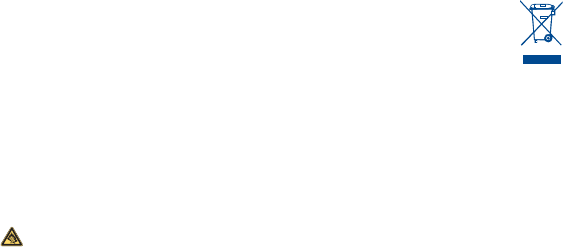
7 8
Over 55°C the legibility of the cellphone’s display may be impaired, though this is temporary and not serious.
Do not open or attempt to repair your cellphone yourself.
Do not drop, throw or try to bend your cellphone.
Do not paint it.
Use only batteries, battery chargers, and accessories which are recommended by TCT Mobile Limited
and its affiliates and are compatible with your cellphone model.TCT Mobile Limited and its affiliates
disclaim any liability for damage caused by the use of other chargers or batteries.
Your cellphone should not be disposed of in a municipal waste. Please check local regulations for disposal
of electronic products.
Remember to make back-up copies or keep a written record of all important information stored in
your cellphone.
Some people may suffer epileptic seizures or blackouts when exposed to flashing lights, or when playing
video games. These seizures or blackouts may occur even if a person never had a previous seizure
or blackout. If you have experienced seizures or blackouts, or if you have a family history of such
occurrences, please consult your doctor before playing video games on your cellphone or enabling a
flashing-lights feature on your cellphone. Parents should monitor their children’s use of video games or
other features that incorporate flashing lights on the cellphones. All persons should discontinue use and
consult a doctor if any of the following symptoms occur: convulsion, eye or muscle twitching, loss of
awareness, involuntary movements, or disorientation. To limit the likelihood of such symptoms, please
take the following safety precautions:
- Do not play or use a flashing-lights feature if you are tired or need sleep.
- Take a minimum of a 15-minute break hourly.
- Play in a well lit environment.
- Play at the farthest distance possible from the screen.
When you play games on your cellphone, you may experience occasional discomfort in your hands,
arms, shoulders, neck, or other parts of your body. Follow these instructions to avoid problems such as
tendinitis, carpal tunnel syndrome, or other musculoskeletal disorders:
- Take a minimum of a 15-minute break every hour of game playing.
- If your hands, wrists, or arms become tired or sore while playing, stop and rest for several hours
before playing again.
-
If you continue to have sore hands, wrists, or arms during or after playing, stop the game and see a doctor.
Prolonged exposure to music at full volume on the music player may cause the listener’s
hearing impairment. Adjust the volume before placing headphones on or in your ear. Only
use headphones recommended by TCT Mobile Limited and its affiliates.
• PRIVACY:
Please note that you must respect the laws and regulations in force in your jurisdiction or other
jurisdiction(s) where you will use your cellphone regarding taking photographs and recording sounds
with your cellphone. Pursuant to such laws and regulations, it may be strictly forbidden to take
photographs and/or to record the voices of other people or any of their personal attributes, and
reproduce or distribute them, as this may be considered to be an invasion of privacy.
It is the user’s sole responsibility to ensure that prior authorization be obtained, if necessary, in order to
record private or confidential conversations or take a photograph of another person; the manufacturer,
the seller or vendor of your cellphone (including the operator) disclaim any liability which may result
from the improper use of the cellphone.
• BATTERY AND ACCESSORIES:
Before removing the battery from your cellphone, please make sure that the cellphone is switched off.
Observe the following precautions for battery use:
- Do not attempt to open the battery (due to the risk of toxic fumes and burns).
- Do not puncture, disassemble or cause a short-circuit in a battery,
- Do not burn or dispose of a used battery in the garbage or store it at temperatures above 60°C.
Batteries must be disposed of in accordance with locally applicable environmental regulations. Only
use the battery for the purpose for which it was designed. Never use damaged batteries or those not
recommended by TCT Mobile Limited and/or its affiliates.
This symbol on your telephone, the battery and the accessories means that these products
must be taken to collection points at the end of their life:
- Municipal waste disposal centres with specific bins for these items of equipment
- Collection bins at points of sale.
They will then be recycled, preventing substances being disposed of in the environment, so that their
components can be reused.
In European Union countries:
These collection points are accessible free of charge. All products with this sign must be brought to
these collection points.
In non European Union jurisdictions:
Items of equipment with this symbol are not be thrown into ordinary bins if your jurisdiction or your
region has suitable recycling and collection facilities; instead they are to be taken to collection points
for them to be recycled.
In the United States you may learn more about CTIA’s Recycling Program at
www.recyclewirelessphones.com
CAUTION: RISK OF EXPLOSION IF BATTERY IS REPLACED BY AN INCORRECT TYPE. DISPOSE
OF USED BATTERIES ACCORDING TO THE INSTRUCTIONS.
• CHARGERS
Home A.C. chargers will operate within the temperature range of: 0°C to 40°C.
The chargers designed for your cellphone meet with the standard for safety of information technology
equipment and office equipment use. Due to different applicable electrical specifications, a charger you purchased
in one jurisdiction may not work in another jurisdiction. They should be used for this purpose only
.
Characteristics of power supply (depending on the country):
Travel charger: Input: 00-240 V, 50/60 Hz, 0.15 A
Output: 5 V, 500 mA
Battery: Lithium 750 mAh.

910
- Reorient or relocate the receiving antenna.
- Increase the separation between the equipment and receiver.
-
Connect the equipment into an outlet on a circuit different from that to which the receiver is connected.
- Consult the dealer or an experienced radio/ TV technician for help.
Changes or modifications not expressly approved by the party responsible for compliance could void
the user’s authority to operate the equipment.
For the receiver devices associated with the operation of a licensed radio service (e.g. FM broadcast),
they bear the following statement:
This device complies with Part 15 of the FCC Rules. Operation is subject to the condition that this
device does not cause harmful interference.
For other devices, they bear the following statement:
This device complies with Part 15 of the FCC Rules. Operation is subject to the following two conditions:
(1) this device may not cause harmful interference
(2)
this device must accept any interference received, including interference that may cause undesired
operation.
Your cellphone is equipped with a built-in antenna. For optimal operation, you should
avoid touching it or degrading it.
As cellphone devices offer a range of functions, they can be used in positions other than against your
ear. In such circumstances the device will be compliant with the guidelines when used with headset. If
you are not using headset ensure that whatever product is used is free of any metal and that it positions
the phone at least 2 cm away from the body.
• LICENCES
Obigo® is a registered trademark of Obigo AB.
microSD Logo is a trademark.
The Bluetooth word mark and logos are owned by the Bluetooth SIG, Inc. and
any use of such marks by TCT Mobile Limited and its affiliates is under license.
Other trademarks and trade names are those of their respective owners.
OT-708A Bluetooth QD ID B015296
eZiText™ and Zi™ are trademarks of Zi Corporation and/or its Affiliates.
Java™ and all Java™ based trademarks and logos are trademarks or registered
trademarks of Sun Microsystems, Inc. in the U.S. and other countries.
10
• RADIO WAVES:
THIS CELLPHONE MEETS THE GOVERNMENT’S REQUIREMENTS FOR EXPOSURE TO RADIO WAVES.
Your cellphone is a radio transmitter and receiver. It is designed and manufactured not to exceed the
emission limits for exposure to radio-frequency (RF) energy. These limits are part of comprehensive
guidelines and establish permitted levels of RF energy for the general population. The guidelines are
based on standards that were developed by independent scientific organizations through periodic and
thorough evaluation of scientific studies. These guidelines include a substantial safety margin designed to
ensure the safety of all persons, regardless of age and health.
The exposure standard for cellphones employs a unit of measurement known as the Specific Absorption
Rate, or SAR. The SAR limit set by public authorities such as the Federal Communications Commission
of the US Government (FCC), or by Industry Canada, is 1.6 W/kg averaged over gram of body tissue.
Tests for SAR are conducted using standard operating positions with the cellphone transmitting at its
highest certified power level in all tested frequency bands.
Although the SAR is determined at the highest certified power level, the actual SAR level of the
cellphone while operating can be well below the maximum value. This is because the cellphone is
designed to operate at multiple power levels so as to use only the power required to reach the
network. In general, the closer you are to a wireless base station antenna, the lower the power output
of the cellphone Before a cellphone model is available for sale to the public, compliance with national
regulations and standards must be shown.
The highest SAR value for this model cellphone when tested is 0.69 W/Kg for use at the ear and
0.95 W/Kg for use close to the body.
While there may be differences between the SAR levels of various cellphones and at various positions,
they all meet the government requirement for RF exposure. For body-worn operation, the cellphone
meets FCC RF exposure guidelines provided that it is used with a non-metallic accessory with the
handset at least 1.5 cm from the body. Use of other accessories may not ensure compliance with FCC
RF exposure guidelines.
The World Health Organization (WHO) considers that present scientific information does not indicate
the need for any special precautions for use of cellphones. If individuals are concerned, they might
choose to limit their own or their children’s RF exposure by limiting the length of calls, or using
“hands-free” devices to keep cellphones away from the head and body. (fact sheet n°193). Additional
WHO information about electromagnetic fields and public health are available on the following website:
http://www.who.int/peh-emf.
Note: This equipment has been tested and found to comply with the limits for a Class B digital device
pursuant to part 15 of the FCC Rules. These limits are designed to provide reasonable protection
against harmful interference in a residential installation. This equipment generates, uses and can radiate
radio frequency energy and, if not installed and used in accordance with the instructions, may cause
harmful interference to radio communications. However, there is no guarantee that interference to
radio or television reception, which can be determined by turning the equipment off and on, the user is
encouraged to try to correct the interference by one or more of the following measures:
11 12
General information ....................
• Internet address: www.alcatel-mobilephones.com
•
Hot Line Number: see “TCT Cellphone Services” leaflet or go to our Internet site.
On our Internet site, you will find our FAQ (Frequently Asked Questions) section. You
can also contact us by e-mail to ask any questions you may have.
An electronic version of this user guide is available in English and other languages
according to availability on our server: www.alcatel-mobilephones.com
Your telephone is a transceiver that operates on GSM networks with 850, 1900 MHz
bands.
Protection against theft (1)
Your cellphone is identified by an IMEI (cellphone serial number) shown on the packaging
label and in the product’s memory. We recommend that you note the number the
first time you use your cellphone by entering *#06# and keep it in a safe place. It may
be requested by the police or your operator if your cellphone is stolen. This number
allows your cellphone to be blocked preventing a third person from using it, even with
a different SIM card.
Disclaimer
There may be certain differences between the user manual description and the
cellphone’s operation, depending on the software release of your cellphone or specific
operator services.
(1) Contact your network operator to check service availability.
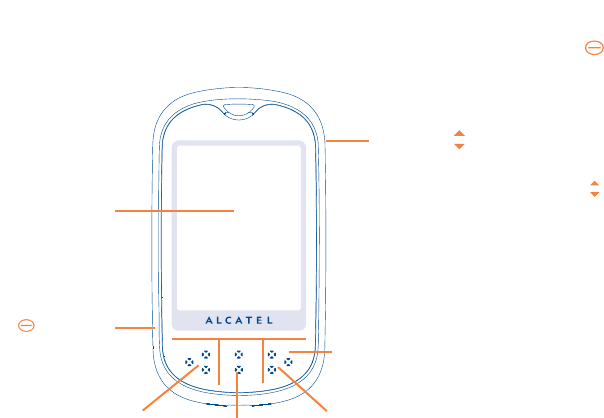
13 14
1 Your telephone ...................... 1.1 Keys&touch area
Power Key
- Switch on your telephone (long press)
- Pop up “Profile Tab” when your telephone is switched on (long press)
- Lock/unlock Touch Area in idle interface (short press)
- Back to idle interface (short press)
- Hung up the call.
Volume Key
- Volume control under Calling and Music player
- Switch 3 Icon Groups in main Menu
- Zoom in or out in Camera mode
- Display the unlock confirmation screen
Touch Lens Area
- Click the icon or menu on the screen to select and perform the related function
- In the Idle interface, Items in Left Bar can be dragged and act as shortcut by short-press.
- By sliding a finger on the touch sensitive area, the user can select items on the main
menu and application tab.
LED Panel
- Slide from right to left to go back to the parent menu
- Slide from left to right to switch between the 3 Icon Groups
- Click to active in certain interfaces (See “Addendum Input”)
Volume Key
Touch Lens Area
Power Key
LED Touch Panel
Operation Aera
“R” Area
“M” Area
“L” Area
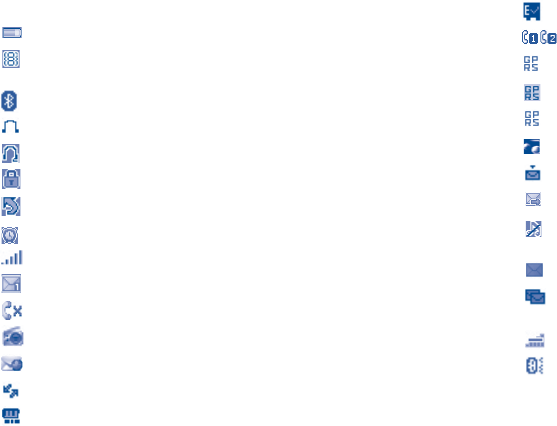
15 16
1.2 Main screen icons (1)
Battery charge level
Vibrate alert: your phone vibrates, but does not ring or beep with the
exception of the alarm (see page 50).
Bluetooth status (Blue - Activated).
Bluetooth status (Connected to an audio device).
Headset connected.
Keypad locked.
Call forwarding activated: your calls are forwarded (see page 37).
Alarm clock or appointment(s) (see page 59).
Level of network reception.
Voicemail message arrived.
Unanswered calls.
Radio is on.
WAP alerts (2).
Roaming.
Memory card scanning in progress.
(1) The icons and illustrations in this guide are provided for informational purposes
only.
(2) Depending on your network operator.
Memory card scanning completed.
Line switching (1): indicates the selected line.
GPRS connection status (Blue - Activated).
GPRS attached.
GPRS connecting.
Music player active.
Message receipt in progress
Sending a message.
Silence mode: your phone does not ring, beep or vibrate with the exception
of the alarm (see page 51).
Message unread
Message list is full: your phone cannot accept any new messages. You must
access the message list and delete at least one message on your SIM card.
Antenna off mode.
A2DP connected.
(1) Contact your network operator to check service availability.
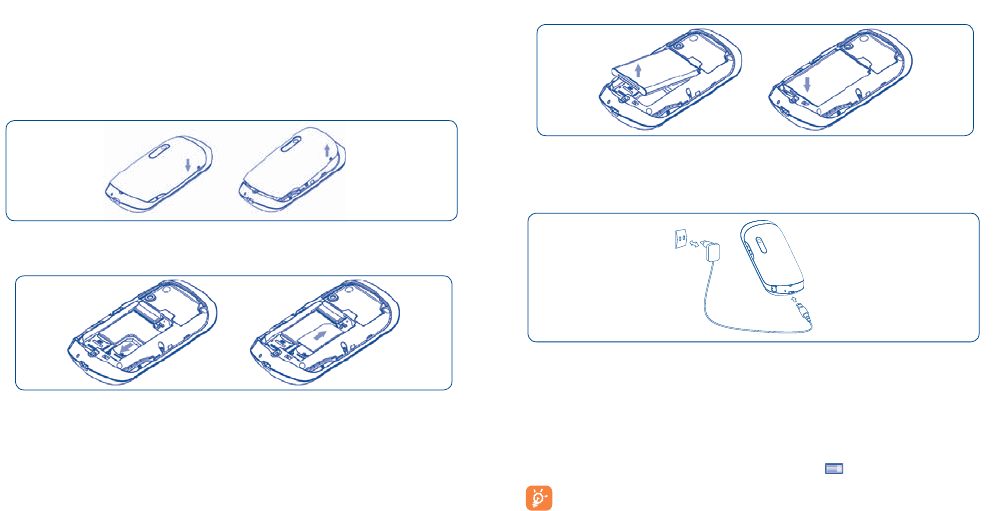
17 18
2 Getting started .......................
2.1 Set-up
Inserting and removing the SIM card (1)
You must insert your SIM card to make phone calls.
Place the SIM card with the chip facing downwards and slide it into its housing. Make
sure that it is correctly inserted. To remove the card, press it and slide it out. Please
power off your phone before you remove the SIM card.
(1) Check with your network operator to make sure that your SIM card is 3V
compatible. The old 5 Volt cards can no longer be used. Please contact your
operator.
Charging the battery
Connect the battery charger
• Charging may take about 20 minutes if the battery is flat.
• Be careful not to force the plug into the socket.
• Make sure the battery is correctly inserted before connecting the charger.
• The mains socket must be near to the phone and easily accessible (avoid electric
extension cables).
• When using your telephone for the first time, charge the battery fully (approximately
3 hours). You are advised to fully charge the battery ( ).
The charge is complete when the animation stops. Only use Alcatel chargers.
Insert and click the battery into place, make sure battery connecting with battery
connector, then close the telephone cover.
Unclip the cover, then remove the battery.
Removing or installing the back cover
Installing and removing the battery
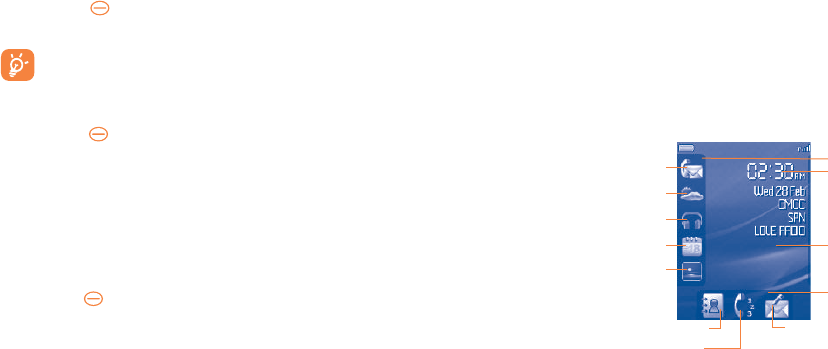
19 20
2.2 Power on your phone
Hold down the key until the telephone powers on, type in your PIN code if
necessary. The main screen is displayed.
If you do not know your PIN code or if you have forgotten it, contact your
network operator. Do not leave your PIN code with your telephone. Store
this information in a safe place when not in use.
If cell broadcast messages are displayed, touch the screen to browse through them or
press the power key to return to the main screen.
While the phone is searching for a network, “Searching/Emergency” will be
displayed.
In the power on screen, you also have access to the functions of “Radio”, “Camera”,
“Music player”, etc. even if there is no SIM card inserted.
2.3 Power off your phone
Hold down the key until the pop-up “Profile tab” appears, then select “Power off”
and confirm.
3
Opearable Bar Introduction(1) ...
3.1 Operable Bar Information
Left Bar
Desktop
Bottom Bar
Click to create Message
Click to dial
Click to go to Directory
Events
Weather Report
Music Player
Calendar
Wallpaper viewer
Short press into
“World clock”.
(1) You may go to “Addendum Input” for details info.
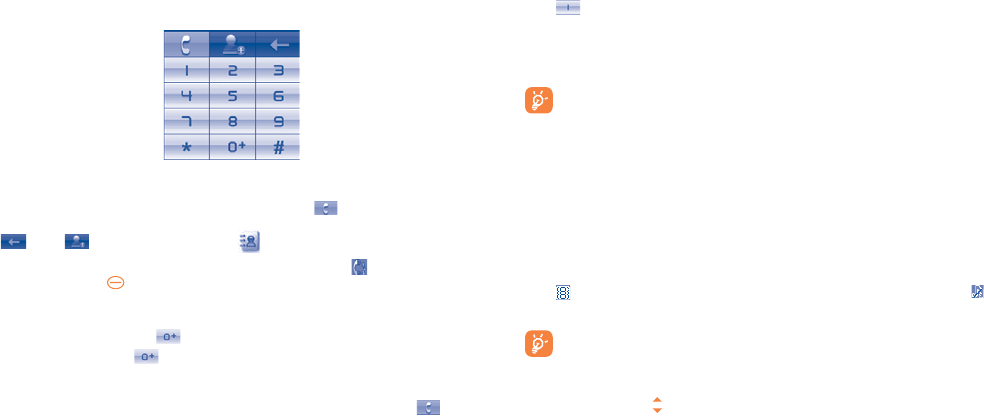
21 22
4 Calls..........................................
4.1 Making a call
Dial
In Dial Interface, dial the desired number then press the key or click “M” area in Led
area to place a call. If you make a mistake, you can delete the incorrect digits by pressing
. Press to save the numbers. Press to enter into Directory.
To access the Dial interface quickly by clicking bottom bar key “ ” in idle interface
(short press Power key to go back to idle interface)
To acess Call Log quickly by clicking “M” area.
To hang up a call, press “cancel” or click “R” Area
To input “ +/p/w”, long press
To input “0”, short press
Making an emergency call
If your phone has network coverage, dial emergency number and press the key
to make an emergency call. This works even without a SIM card and without typing
the PIN code. (1) Contact your network operator to check service availability.
4.2 Calling your voicemail (1)
Your voicemail is provided by your network to avoid missing calls. It works like an
answering machine that you can consult at any time. To access your voicemail, hold
down key.
If the access number for your operator’s voicemail service does not work, dial the
number that you were given. To change this number at a later date, refer to “My
numbers” (see page 36).
To use your voicemail service from abroad, contact your network operator
before leaving.
4.3 Receiving a call
A. When you receive an incoming call, the LED will flicker to notify you.
B. When the phone is Locked, click the “unlock” button. You can then click the “Answer”
or “Reject” button to complete the operation in the touch screen. You can also click the
“L” Area to answer a call and “R” Area to “reject” a call.
C. When the phone is unlocked you can directly answer or reject a call.
If the icon is displayed, the vibrator is activated and there is no ringtone. If the
icon is displayed, the phone does not ring or vibrate.
The caller’s number is displayed if it is transmitted by the network (contact
your network operator to check service availability).
Muting the ringtone
Hold down the volume key for Mute.

23 24
4.4 During a call
Available functions
During a cal you can press “Option” to use your directory, diary, short messages etc.
without losing your caller.
Call on hold
Ongoing call
Handsfree
WARNING: move the handset away from your ear while using the
“handsfree” option because the amplified volume might cause hearing
damage.
Directory
Messages
Calendar
Services
(1)
Voice memo (record your current call).
You can switch the audio speech from handset to BT device when connected.
Adjusting the volume
You can adjust the sound level during a call using the Volume key.
Handling two calls
• Answering a second call (ensure that “Call waiting” is activated, see page 37).
• To call a second party during a call, dial the number directly.
(1) Contact your network operator to check service availability.
4.5 Conference calls (1)
Your phone allows you to talk to several people at the same time (up to five). If you
are on a double call, press “Options” and select “Conference”. If a third call comes in,
answer it by pressing the “Answer” and speak with your new caller.
This caller becomes a member of the conference if you press “Options” and select
“Add to conference”. Pressing “End” disconnects the current call.
To end the conference call, press “Options” and select “End conf.”
4.6 Line switching (1)
Your SIM card can contain two distinct telephone numbers. Under “Call register”,
choose “Line switching” and then select a default line; all your outgoing calls will be
made from this number. Incoming calls, however, will continue to use either of the two
lines.
The services programmed on the default line do not impact those selected on
the other line.
(1) Contact your network operator to check service availability.

25 26
• MESSAGES
• WEB
• CALENDAR
• NOTES
• CLOCK
• CALCULATOR
• FUN
• CAMERA
• BLUETOOTH
• RADIO
• MUSIC PLAYER
• WEATHER
• PROFILES
• IMAGE VIEWER
• FILE MANAGER
• CALL REGISTER
• SERVICES (1)
• SETTINGS
(1) Contact your network operator to check service availability.
6 Messages .........................
You can create, edit and receive SMS, MMS with this cellphone.
MMS enables you to send video clips, images, photos, animations and sounds to other
compatible cellphones.
The MMS function can only be used if the service is provided by your operator,
and if your contract includes the MMS option and if all the parameters for
MMS have been entered (see page 31).
6.1 Messages: Text/Multimedia message (1)
6.1.1 Create message
You can click in idle interface to create a message. Or select “Messages” from the
Main Menu to create text/multimedia messages.
An SMS will be converted to MMS automatically when images, videos, audio, slides or
attachements are inserted; the message contains more than 8 pages of text.
5 Menu switch ............................
The Main Menu consists of three icon groups. You can slide on LED panel or touch 3 dots
in screen to switch main Menu; Press “M” area to back to idle Interface.
You can also use the Volume key to switch main Menu.
(1) Depending on your network operator.

27 28
You can type a message, but you can also modify a predefined message in Templates
or customize your message by adding pictures, photos, sounds, titles, etc. (only available
while editing an MMS). While writing a message, select “Options” to access all the
messaging options.
You can save your messages that you send often to Drafts or Templates (MMS
only).
An SMS message of more than 160 characters (the number of characters
depends on your language) will be charged as several SMS. An MMS message
containing photos and/or sounds may also be billed as more than one
message.
6.1.2 Inbox
All received messages (read and unread) are stored in the same Inbox.
When viewing your messages, you will find the following status icons, depending on the
type of message: unread SMS in phone, unread SMS in SIM card, read SMS in
phone, read SMS in SIM card, unread MMS in phone, read MMS in phone,
message reception in progress and message sending in progress.
Receiving and reading SMS/MMS
When you receive a new message, a beep sounds and the icon showing the
number of new messages will appear on the screen, The LED will also flicker.
Once you receive a message, the following options are given: View, Reply, Forward
the message to another person, Edit, Group by sender, Delete, Delete all, Move
to archive and extract number, URL or email address (Use number/Use URL/Use
email address), etc.
Group by sender
Messages can be grouped by sender (“Option/Group by sender”). You are able to
quick search the messages by pressing the key associated with the first letter of sender’s
name.
Group unread message
Unread messages will always be positioned above the read messages.
29 30
6.1.3 Outbox
All failed to send messages.
6.1.4 Sent
All sent messages.
6.1.5 Drafts
All draft messages.
6.1.6 WAP Alerts
Store Web push messages.
6.1.7 Empty folder
Delete all messages in “Inbox/Outbox/Sent/Drafts…”.
6.1.8 Templates
A list of predefined messages is available. Select one, edit it if required, and then send it.
You can also create your own predefined multimedia messages.
6.2 Voice message
Record voice and send as MMS.
6.3 Photo message
Take a photo and send as MMS.
6.4 Video message
Take a video and send as MMS.
6.5 Voicemail
View and edit the voice mail number.
6.6 Settings
6.6.1 Text message
Profile settings • Profiles can be retrieved directly from SIM card. Alternatively, you
can create your own profile.
General setting • Delivery report, request for acknowledgement of delivery report
On/Off. Reply path(1) show reply path.
Alphabet • Enables the definition of SMS data coding for
management SMS sending.
Memory status • Memory used on the phone.
Preferred • Select default message storage, SIM or phone.
storage
Pref. Bearer • Bearer preference.
(1) Depending on your network operator.
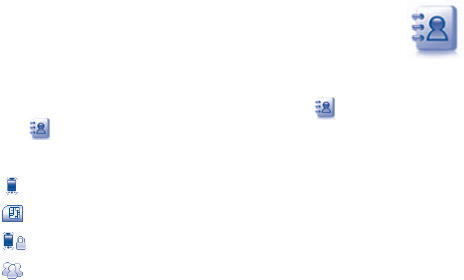
31 32
6.6.2 Multimedia message
Edit • Set edit mode, image size and signature.
Sending • Set the values for validity period, Read report, etc.
Retrieve • Set the values for Home network, Roaming network, etc.
Profiles • Follow the same procedure as for setting your Web
connection.
Memory status • Memory used on the phone.
6.6.3 Broadcast SMS (1)
Receive mode • Enable to receive broadcast SMS.
Languages • Language selection.
Channel setting • Add/Edit channels.
(1) Depending on your network operator.
7 Directory .................................
7.1 Consulting your directory
To access the Directory from the main screen, select the icon from the menu or
click from Idle interface to access Directory.
You have 5 directories:
General
SIM directory
Phone directory
Group
In addition to the directories already provided, you can create up to 5 groups (maximum
100 entries per group).
Searching for a contact
You can search for a contact by multi-pressing the keys associated with the first letters
and the other ones of their names.
Reading a file
Select a name from your directory, then click to read the file.
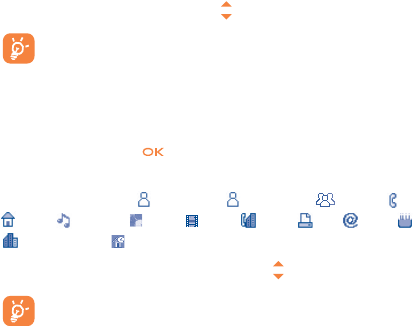
33 34
Sending Vcard via Bluetooth
Selecting the Vcard you wish to transfer (“Options\Send vCard\By Bluetooth”).
Making the call
Click “Dial” in “Option” list or click M area after selecting Name. If several numbers are
associated with the name to be called, you must first choose the number from the list
(Cellphone, Home, Office, etc.) using the key.
Information in the directory and the diary may be sent to and received from
a computer using the PC suite.
7.2 Creating a file
Select the directory in which you wish to create a file, press the “Options” softkey,
select “Create file” then .
When you create a new contact in the product directory, at least one of the following
fields must be filled in: First name, Last name, Group, Cellphone,
Home, Ringtone, Image, Video, Work, Fax, Email, Birthday,
Company, URL.
You can move from one field to another using the key.
If you use your phone abroad, store the numbers in your directories in
international format “+” followed by the country code (see page 21).
7.3 Available options
From the list of names in SIM directory, General directory or Group you can access
the following options:
View • View a complete file: name, numbers, address, e-mail, etc.
Create file • Create a file (name, numbers, address, e-mail, etc.) in the desired
directory.
Dial • Make a call
Create group • Create a group of files.
Send message • Send an SMS/MMS to a contact you selected from the directory.
Edit • Modify the contents of a file: name, number, ringtone, image, etc.
Delete • Delete the selected file.
Delete group • The group and its files will be completely deleted.
Default storage • Set default storage to store new contacts.
Set as • Set the number as your favourite, whose ringtone
My favorite could be different.
Set ringtone • Set the number as your favourite whose ringtone you would like
to be different.
Send vCard • Exchange data via SMS, MMS, Bluetooth or save to memory
card.
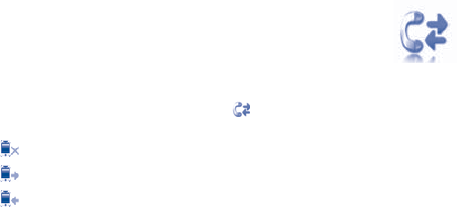
35 36
Directory manage • Copy Copy a file from SIM directory to Phone
directory, vice versa.
• Copy all Copy the whole directory to the SIM or
General directory only if there is sufficient
memory.
• Delete all Delete all the files in the current directory.
• My number Type in, modify or send the user’s own
number by SMS.
• Memory status View used and available space in SIM and
Phone directory.
• Display format Select the format for name display.
8 Call register ....................
8.1 Call memory
You can access your call memory by clicking from the main screen or click “M” area
on LED area in dial interface. Choose the option of the desired list:
Unanswered calls
Outgoing calls (Redial)
Answered calls
Select a number from the call memory and press the “Options” softkey to View call
details, Create text/multimedia message, Save or Delete the selected number or
clear the entire list (Delete all).
8.2 My numbers
Type in or modify your telephone number or the number to access your voicemail and
confirm by clicking. Your telephone number is usually written on your SIM card.
8.3 Billing
You can access different items with this option:
Amount • You can view the total cost of charged calls, modify it or reset
it and enter the cost of a Telecom Unit in the currency of your
choice.
Duration • You can view the total duration of all outgoing calls or reset it.
GPRS counter • Management of the volume of data communications charged for
(in kilobytes).

37 38
Beep duration • You can activate or cancel the beep emitted during a call with a
specified frequency (enter the frequency and confirm by click).
8.4 Call settings (1)
You can access a number of items with this option:
8.4.1 Call waiting
Activate/deactivate the notification of a second incoming call by a beep.
8.4.2 Call forwarding
You can activate, cancel or verify the status of the call forwarding to the voicemail or to
a specified number. The following configurations are possible:
• Unconditional: systematic forwarding of all your calls. The icon is displayed.
• Conditional: if your line is busy, if you don’t answer or if you are outside the network
range.
• If busy, no reply or unreachable.
8.4.3 Call barring
You can activate or deactivate the call barring for outgoing and incoming calls. The
various options are:
Outgoing calls • The following configurations are possible:
• All calls • All outgoing calls are barred.
• All calls except • All outgoing calls except those in SIM directory are
SIM directory barred.
(1) Contact your network operator to check service availability.
• International calls • Outgoing international calls are barred.
• International • Outgoing international calls except those to your
except home country of subscription are barred.
Incoming calls • The following configurations are possible:
• All calls • All incoming calls are barred.
• All calls except • All incoming calls except those in SIM directory are
SIM directory barred.
• Roaming • Incoming calls are barred when you are abroad.
Cancel all • Deactivate all call barring.
barring
Change barring • Change the original PW for activating call barring.
PW
8.4.4 Caller ID
Set by network/Hide number/Send number
8.4.5 Line switching
(1)
Line switch between line 1 and line 2.
8.4.6 Auto redial
You can activate or deactivate the automatic callback of your party for calls that do not
get through the first time.
(1) Depending on your SIM card.
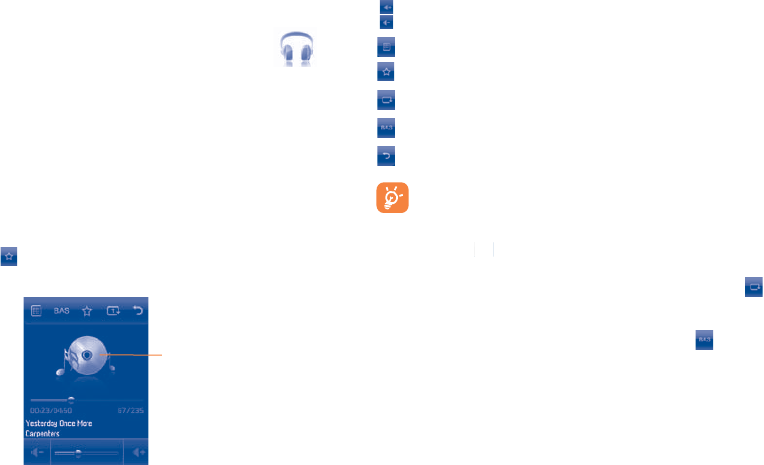
39 40
9 Media applications ...................
9.1 Music player
(1) ..........................................................
Access this feature from the main menu by selecting “Music player”. You will have full
flexibility of managing music both on your cellphone and memory card.
You can have access to your music files through one of the following:
All songs • Contains all songs both on phone memory and memory card.
Folders • Category of songs in folder.
Update songs • Update the information of songs saved in phone or memory
card.
Album/Artist/ • Music files are categorized by Album, Artist or
Genre Genre based on information stored in the tags. Those missing such
information will be classified as “Unknown files”.
My star list •
You can simply add your favorite songs to “My star list” by holding
down during playing music (max 100).
Use keys to manage Music player:
(1) Only music files in mp3 format will be visible in Music player.
Click or touch “CD cover”
to open or close the
operable options.
The available options are:
Set volume level
Option menu of Music Player
place the current song in my star list
switch Equalizer
change play mode
Back to parent menu
You also can manage Music player for “Play/pause, forward/backward”
within LED Area (see “Addendum Input”).
9.1.1 Settings
Access by clicking for following options:
Play mode • Normal, Repeat current, Repeat all, Shuffle and Repeat shuffle.
You may also customize it by simply clicking whilst playing
music.
Equalizer • Different music styles are preset in the phone. You may also
customize them by simply clicking whilst playing music.
Play in Bluetooth • In play mode select to switch between play in speaker or play
in BT stereo headset mode.
Display • Enable your player to display spectrum, song info. or lyric.
9.1.2 Playing with lyrics
Lyrics can be displayed in synchronization with the music.

41 42
9.2 Image Viewer ...................................................
A library links to the pictures in “My creations” and “My images” in phone to be
shown in list, slide, or thumbnail, set as Wallpaper, Screen saver, Power on/off display, and
Contact ID, or sent by MMS, Email, Bluetooth.
9.3 Video player .....................................................
Contains all video clips both in phone and memory card and enables you to Play,
Send (by MMS, Email, or Bluetooth), Delete, Delete all, Rename, Sort (by
name, type, time or size) and Copy or Move the video/videos, and to Download/
Capture new video clips.
9.4 Radio..................................................................
Your phone is equipped with a radio (1) with RDS functionality. You can use the
application as a traditional radio with saved channels or with parallel visual information
related to the radio program on the display if you tune to stations that offer Visual Radio
service. You can listen to it while running other applications.
To use it, you must plug in your headset, which works as an antenna connected
with your phone.
(1) The quality of the radio depends on the coverage of the radio station in that
particular area.
Available options:
Channel list • Open the list of saved stations.
Save channel • Save the current tuned station to the “Channel list”.
Auto search • Start auto search and stations will be automatically saved to
“Channel list”.
Enter the • Enter the frequency manually.
frequency
Turn off • Stop playing the radio.
Record • Record the radio and files will be automatically saved to “Tools\
Voice memo\List”.
Settings • Click “Option” to change settings.
Activate • Listen to the radio using loudspeaker or headset.
loudspeaker/
Play in headset
Activate mono • Switch between mono and stereo mode.
mode/stereo
mode
Update station •
Save RDS information as station name in the channel
list.
name (1)
Optimize audio •
Optimize the audio quality.
frequency
Click “Option” to enter the mode of “Manual tuning” and go to the
previous/next station by pressing or “L” and “M” area on LED panel in the
interface of Radio.
(1) Availability on RDS information detected..

43 44
10 Internet ................................
10.1 Web ..........................................................................
10.1.1 Homepage
Launch the Web browser with the homepage of the default profile.
10.1.2 Bookmarks
Access your favorite sites.
10.1.3 Go to URL
Enter the URL of Web site.
10.1.4 Open file
Open externally saved webpage files in File manager.
10.1.5 Recent pages
Pages which you recently browsed.
10.1.6 Offline pages
Pages available for offline viewing.
10.1.7 Profiles
Customize your Web access.
10.2 Weather
(1)
Your phone is equipped with a weather function for consulting uthe forecast of favourite
cities up to 3 days in advance.
To access this function, select in main Screen.
You are able to view a list of cities, add or delete cities, or set your favourite city.
To view weather information for other cities. Press key up or down.
To display today’s weather information in full screen, Select “view” in “Option”.
Available options:
More info Search more weather info online.
Forecast Display 3-day weather forecast.
Update Refresh weather information.
My cities List all my cities, you can add new city, set default city, delete the selected
city, etc. via “My cities\Options”.
Settings Set unit, update mode and network.
(1) May cause additional network charges for data flow to provide this service. Extra
fees might also be charged in roaming states.
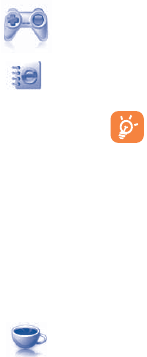
45 46
11 Fun .......................................
11.1 EBook ...............................................................
A bookshelf contains the electronic books (.txt and .pdb file only). While reading the
book, you may add bookmarks, or reach the text by searching words, phrases (Options\
Search, Options\Jump to).
Available options:
Open Open the current ebook
Book info Display the detailed info (title, size and format) about the book.
Delete Delete the current book.
Delete all Delete all the books.
Sort Sort the books by name, type, time or size.
Global settings Set the font, scroll mode, display format, storage, etc.
Help List all hotkeys.
11.2 Java .....................................................................
11.2.1 Launch an application
Select “Java” to launch applications.
11.2.2 Java settings
The “Java” menu allows you to manage Java settings, in which you may set Java audio,
vibration, network and identify how much Heap size is available.
11.2.3 Java downloading
You can download new Java™ applications in the “Java” menu by selecting “Download”
from “Options”. The list of available Web bookmarks dedicated to the application
download will then be displayed.
Select the appropriate bookmark for the desired Web page.
Each downloaded java game will be assigned as a main menu display for quick
access.
Disclaimer
Downloading or running applications will not damage or alter any software already in
your cellphone designed to support Java™ technology.
TCT Mobile Limited and its affiliates waive any responsibility and refuse to guarantee
applications that are subsequently used, as well as for all applications not embedded in
the handset upon purchase.
The purchaser alone bears the risk of loss, damage or defect of the handset, or of
applications/software, and generally of any damage or consequence resulting from the
use of the said applications/software. In the event that the said applications/software, or
the subsequent setup of any function are lost due to technical reasons resulting from the
handset being replaced/repaired, the cellphone owner should repeat the operation and
download or set up again. TCT Mobile Limited and its affiliates grant no guarantee and
disclaim any responsibility if the operation cannot be repeated or cannot be performed
without incurring some cost.
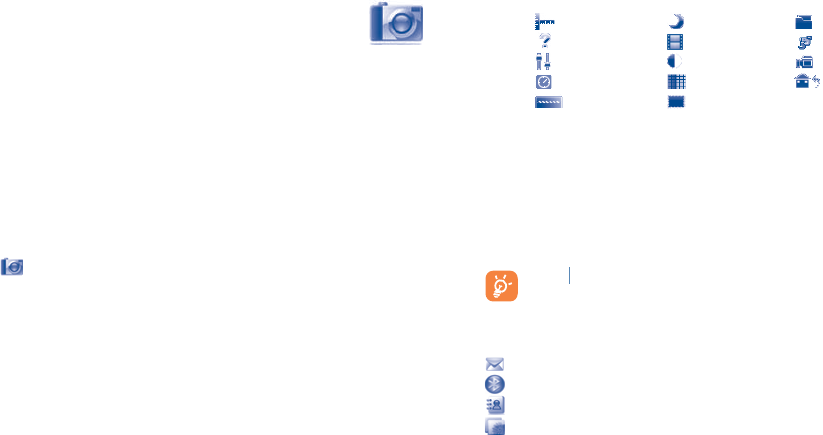
47 48
12 Camera ..........................
Your cellphone is fitted with a camera for taking photos and shooting videos that you
can use in different ways:
- store them in your “File manager”.
- send them in a multimedia message (MMS) to a cellphone or an email address.
- customize your main screen (see page 61).
- select them as incoming call image to a contact in your directory.
- transfer them by data cable or microSD card to your computer.
- modify your photos by adding frames (see page 49).
12.1 Access
Select to access the function from main screen:
12.2 Camera
12.2.1 Take a photo, save or delete
The screen acts as the viewfinder. Position the object in the viewfinder and Click “M”
area (LED is lighting) or click viewfinder directly to take the picture and the pictures
will be automatically saved. If you don’t want it, you may directly delete it by Click left
softkey “Delete”.
12.2.2 Settings in framing mode
Before taking the photo, you can adjust a number of settings by using the following
shortcuts:
Selected options bar:
Image size
Capture mode
Quality
Timer
Banding
Night mode
Exposure Value
White balance
Color mode
Add frame
File manager
Saving location
Access video
Restore default
From the photo shot screen, press the “Options” softkey to access: “Image size”,
“Capture mode”, “Quality”, “Timer”, “Banding”, “Night mode”, “Exposure
Value”, “White balance”, “Color mode”, “Add frame”, in addition to the following:
My creation • Go to the file manager feature.
Saving location • You may choose saving location if MicroSD card is inserted.
Access Video • Access Video recording mode.
Restore default • Restore all settings to default values.
Hotkeys • List all hotkeys.
clickclick hide/unhide option bar,click icons to setting; click up/ down arrow to
switch setting icons
12.2.3 Options available after taking the photo
Four transparent icons available on the photos for your selection:
: Send Messages
: Via Bluetooth
: Set contact image
: Set as Wallpaper
12.2.4 Modifying images
Access the “File manager\My creations” after taking a photo, and then select
“Modify”.

49 50
12.3 Video
You can record a video clip of unlimited length, as long as the battery sustains and there
is sufficient memory.
We strongly advise you to change the default folder to “Memory card” to
store your photos and videos.
12.3.1 Framing mode
When you enter the “Video” function, your are in Framing mode. Use the cellphone
screen as a viewfinder and press the “Options” softkey for the settings of White
balance, Exposure Value, Night mode, Banding, Quality, Record duration,
Audio, Color mode, Saving location, to access the “File manager/My videos”,
and to restore default value.
12.3.2 Recording mode
Once you have chosen your settings, you can launch the recording of your video by
clicking “M” area (LED is lighting).
If you receive a call in recording mode, video recording will be stopped and a pop
up message will inquire if you want to save it.
12.3.3 Playing mode
In the list of “My videos”, press “Options” to play the video and send
by MMS, Email or Bluetooth.
13 Profiles ..................................
With this menu, you may personalise ringtones for different events and environments.
13.1 General
To modify the sound settings, press “Options” and select “Edit” and you will see the
below functions using :
Select a melody from the list using the key then confirm by pressing
(see page 40).
Mode (normal, discreet, vibrate...). You may set your phone ringtone to Normal,
Discreet (ring with beep), Vibrate (all sounds are replaced by vibrations except for
alarms), Vibrate and ring, Vibrate then ring, Beep and vibrate, Silence (no sounds
except for alarms, the icon will be displayed). Ringtones sound with increasing
volume.
Adjust the volume using the key.
Select the type of key beep.
Select a melody for a new incoming message.
Select a melody for an alarm or appointment.
Power on beep.
Power off beep.
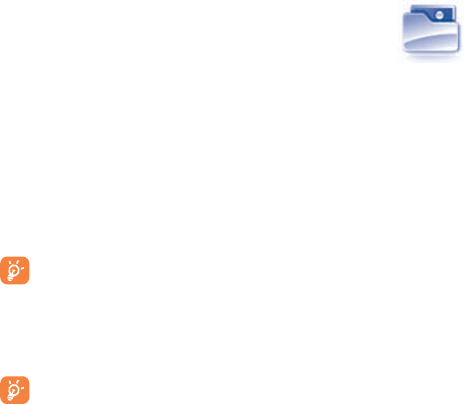
51 52
13.2 Silence
This profile will turn off all ringtones, even notification sounds.
13.3 Outdoor (loud)
It is a profile designed for outdoor users who requires louder ringtones.
13.4 Meeting
When activated your cellphone vibrates when a new event is due but the phone does
not ring or beep with the exception of alarms.
13.5 Flight mode (antenna off mode)
Antenna off mode can be used to increase standby duration but you will have no voice
call, Bluetooth or messaging functions.
14 File manager ....................
You will have access to all audio and visual files stored in phone or memory card in
File manager.
14.1 My audios
Choose an audio for the ON/OFF screen, for an incoming call, a message alert, power
on/off ringtone or an alarm and scheduler.
The “My audios” album contains the following folders (1):
- Music: full track music.
- Melodies: melodies that can be set as ringtone.
- Recorded: all recorded sounds.
- General: contains all audio files stored in phone or memory card.
DRM: Digital Rights Management feature allows sounds and images to be played
while protecting the associated copyright. DRM counter-based files and files
with expired rights will not be automatically played when scrolling the list.
14.2 My images
You can select an image or a photo as wallpaper, ON/OFF screen, or assign it to a
contact in the directory.
The images will be displayed in alphabetical order.
14.3 My videos
The “My videos” album contains all video clips recorded by the user, originally
embedded in the phone and downloaded to the phone or memory card.
(1) The embedded folder names cannot be modified. However, in certain cases, you
can modify, delete and add items included in these folders.
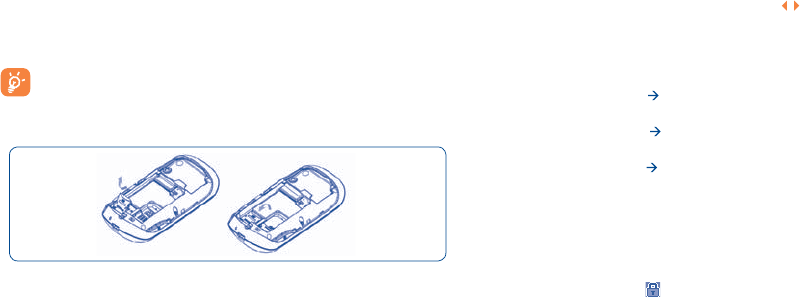
53 54
14.4 My creations
This feature stores all the photos captured by your cellphone.
14.5 Unknown files
Store files of unsupported format.
14.6 Ebook
A bookshelf contains the electronic books (.txt and .pdb file only).
14.7 Memory card
You can access all files stored in memory card here.
When a memory card is inserted for the first time, it will be scanned and the
default folders will be created.
Inserting or removing the memory card
Remove back cover and battery, push outside and lift slot cover,put the MicroSD card
into the slot as his shape,then lay down slot cover and push inside.
Available options
New folder • Create more folders.
Delete folder • Remove folders.
Rename folder • Edit folder’s name.
Empty folder • Delete all files in one folder.
Memory card • To format or to query its memory status.
14.8 Managing audios, images, videos and creations
According to the item chosen, you can access some of the functions below:
View • View the selected image. If you want to view all the pictures in your
folder in a slideshow hold down on the current picture.
Play • Play the selected video.
Send (1) • Send the audio/image/video.
Delete • Delete the audio/image/video selected (not applicable for embedded
items).
Set as • - Image wallpaper, screen saver, switch ON/OFF, assign it to a
contact.
- Sound ringtone, message beep, switch ON/OFF, assign it to a
contact.
- Video Screen saver, switch ON/OFF or assign it to a contact.
Modify • Modify an image (2).
Download • Download new items.
Rename • Rename the audio/image/video.
Sort • Sort the files by name, type, time and size.
(1) Files marked with cannot be sent.
(2) Only applies to images that can be cleared but not for copyrighted files.

55 56
Move to phone/
memory card
• Move a file from the product memory to the memory
card and vice-versa.
Properties
• Display part of the ID3 Tag content of an MP3
file.
Activate • DRM file option.
Copy to phone/
memory card
• Copy a file to the phone memory or the memory card.
Delete • Delete the files except the embedded ones.
Delete all • Delete all the files except the embedded ones.
Capture • Access “Camera” function directly.
Picture show • Show pictures in list, slide, thumbnail view.
14.9 Formats and compatibility (1)
- Sounds: mp3, midi, wav, amr
- Images: jpg, gif
- Videos: 3gp, M-JPEG
14.10 Memory status
Indicates how much space is used and how much is currently free on your phone and
memory card (if any).
(1) Depending on product and market.
15 Bluetooth™
(1)
......................
Access this feature by selecting “Bluetooth” in main menu.
To use your phone with a Bluetooth device, you need to proceed in two steps:
- Pair and register the device to your phone,
- Select it to use hands-free communication. Only one Bluetooth audio device
(your Bluetooth headset or your Bluetooth car kit) can be connected during the
communication.
Pair and register your Bluetooth device
Activate the Bluetooth feature by selecting the “Bluetooth\Activation\On” option.
Then enter the “Device list” menu to search for connectable Bluetooth devices and
select the device you want to be paired with in the list. If the bluetooth device has no
keyboard, enter its default password to register it with your phone. If the Bluetooth
device has keyboard/keypad, enter the same set of password on both handset and the
device to get it registered.
From the list, press the “Options” softkey to connect/disconnect, rename, search for
new devices or delete an unconnected one from the list.
Don’t forget to turn on your Bluetooth device and activate the pairing mode
while pairing it with your phone.
(1) You are highly recommended to use Alcatel OT-BM82 (mono) Bluetooth headsets,
which have been tested and proved fully compatible with OT-708
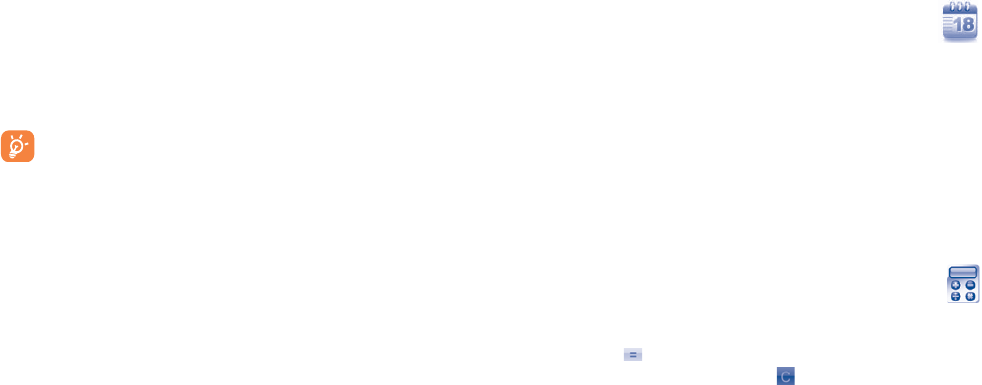
57 58
Available functions
Data transmit • Exchange files with another bluetooth device.
Handle a call • Initiate or receive a phone call with a Bluetooth headset.
Listen to music • Support A2DP profile.
Settings
• Visibility: Select whether you want to hide (“Hidden”) or show to all (“Shown to
all”) your phone.
• My phone’s name: you may change your phone name, which is visible to the
others.
Always activate Bluetooth in your phone first before connecting it to a
Bluetooth device. Be aware that Bluetooth activation will slightly affect
battery life of your phone.
Bluetooth technology allows free wireless connections between all Bluetooth-compliant
devices within short range. Please make sure that the Bluetooth headset or the
Bluetooth car kit and your cellphone are in this range and set as “Visibility”.
Your phone is Bluetooth™ v1.1, v1.2 and v2.0 compatible.
16 Others ...................................
16.1 Calendar .............................................................
Once you enter this menu from the main menu, there is a monthly-view calendar for
you to keep track of important meetings, appointments, etc. Days with events entered
will be marked in color.
Available options:
Create • Create an appointment.
View appointments
• See today’s appointments.
List all appointments • See all the created appointments.
Jump to date • Input the required date and it will be immediately
highlighted.
16.2 Calculator .............................................................
Access this feature by selecting “Calculator” from the main menu.
Enter a number, select the type of operation to be performed, and enter the second
number, then press key to display the result.
Once an operation is complete, you can select to clear numbers and carry out a
new operation.
To return to the main screen, Click “R” Area or slide from right to left on LED control
panel.

59 60
16.3 Notes ...........................................................................
You can create a note text or voice format by accessing “Notes” from the main menu.
Available options:
Open • Open and view note.
Send
• Send by SMS, MMS or Bluetooth.
New text note/
voice memo
• Add new text note or voice memo.
Delete • Delete note.
Input mode • Select input method.
Languages • Select language.
While recording a voice memo, you can define the audio format (AMR, WAV), Quality
(High/Low), and Storage (Phone, memory card).
16.4 Clock ............................................................................
16.4.1 Alarm
Your cellphone has a built-in alarm clock with a snooze feature. You can set up to five
separate alarms and choose whether or not the alarm should repeat.
Repeat • You may select Once (default)/Every day/Days.
Snooze • The alarm will repeat at regular intervals. You may snooze it by setting
“Alarm/Edit/Snooze” menu.
16.4.2 Clock
Allows you to display date and time settings including 12/24h format.
Also you can set the daylight saving adjustment.
16.4.3 World clock
The World clock shows current local time and the time in different cities. You may view
up to 3 cities at one time (Options\Set as my city). Also, you can add a maximum of
10 new cities to the list (Options\Add).
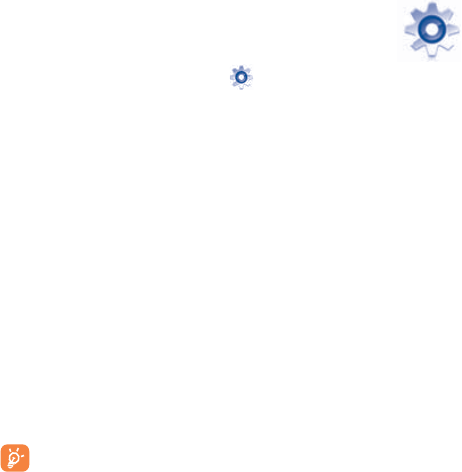
61 62
17 Settings .................................
From the main menu, select the menu icon and select the function of your choice
in order to customize your telephone.
17.1 Touch Settings
17.1.1 Touch calibration
You have two options: LED touch calibration & LCD touch calibration. To calibrate the
touch screen,click anywhere on the screen to start calibration.
17.1.2 Touch Vibration
You may choose “on/off” for vibration when you touch screen or LED area.
17.2 Display
17.2.1 Home screen display
Wallpaper
The wallpaper is displayed when you switch on your telephone.
By selecting “Wallpaper” you can customize it by replacing the default image displayed
on your telephone.
When you receive an event (incoming call, SMS/MMS, notifications, etc.) the
icon, type and number of events will be displayed on your Widget Bar allowing
you to consult them directly.
Screen saver
If you activate this option, the screen saver will be displayed shortly after the wallpaper.
You can choose a picture or an animation as your screen saver.
Weather forecast (On/Off)
Select On/Off to display weather information on main screen.
17.2.2 Theme
This function enables you to customize the graphic style and the colours of your
telephone.
17.2.3 Power On/Off
(1)
You can customize your welcome animation or image that appears when you switch
on your phone.
You can also customize your OFF screen with an image or animation.
17.2.4 Brightness
You may adjust black level with respect to LCD display.
17.2.5 Backlight
You may choose backlight time for screen.
17.3 Languages (2)
Display language for messages. The “Automatic” option selects the language according
to the home network (if available).
17.4 Headset mode
Switch audio play (incoming call, message beep, alarm beep...) between Headset only
and Phone&Headset.
(1) Depending on the model.
(2) Contact your network operator to check service availability.

63 64
17.5 Screen lock
17.5.1 Auto lock
Your Screen and LED Panel is locked automatically or can be locked manually by short
press the power key in idle interface
Unlock the Screen and LED Panel
Short press power key when locked
Or press Volume key, pop up unlock comfirmation bar, select “Press” button to
unlock.
17.5.2 Unlock before answering call
You can choice unlock Screen before you answer a call
When making a call the screen is locked automatically. You need to select the
“unlock” button before ending the call or enter Option. When plugged in, the
charger will unlock automatically.
17.6 Numeric keys
17.7 Input mode
Please see chapter “Latin input mode”, page 67. In addition to the specific characters
table for Cyrillic, Chinese, other data input modes are also available in your telephone.
This feature allows you to write short messages and add names with special characters
to your directory.
17.8 Vocabulary
You have a Vocabulary to which you can add your own words in addition to those
suggested by the predictive input system. When you consult your Vocabulary, you can
add, modify or erase words by using the “Options” softkey.
17.9 Security
Activate PIN • The SIM card protection code is requested each time the
phone is powered on if the code is activated.
Change PIN • Change PIN code.
Change PIN2
• A protection code for certain SIM card features (Billing/Cost/
FDN, etc.) will be required if you attempt to access it, when
they code is activated. Select to update it with a new one
(between 4 and 8 digits).
Activate phone code • If the code is activated it will be required each time the phone
is powered on.
Change phone code • Change phone password, default is 1234.
Fixed dialed number • Allows the phone to be “locked” so that it can only dial certain
numbers, or numbers with certain prefixes. To activate this
function, PIN2 code is mandatory.
65 66
17.10 Networks
Network selection
• Preferred • List of networks to which you wish to be connected in order
of priority.
• Select network • The choice of network connection is left up to the user.
• Search mode • Network connection can be switched between “Manual”
and “Automatic”.
GPRS connection (1)
• When needed • GPRS mode active depending on connection requirements.
• Always • GPRS mode continuously active.
17.11 Connectivity
A set of profile settings for messaging (MMS) and WAP connection.
(1) Depending on network availability.
18 Making the most of your
cellphone ................................
18.1 PC suite
We prepare a PC suite for you, you can download it for free from the website. The PC
suite includes:
- Backup/restore
• You can backup the important data in your cellphone and restore them when
needed.
- GPRS Modem
• Use your cellphone to connect PC to the internet.
- Multimedia Personalization
• Customize your cellphone with images, animations and melodies.
- Music management
• Create and transfer playlists with music files and provide lyrics editing.
- Messaging
• You can compose SMS/MMS easily on your PC and transfer them to phone.
Supported Operating Systems
- Windows 2000/XP/Vista
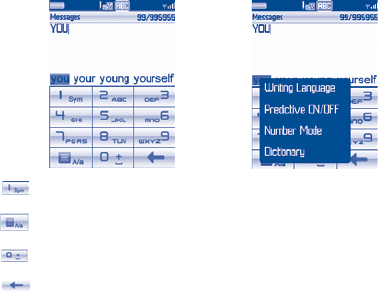
67 68
19
Latin input mode/character
table
(1)
.......................................
To write messages, there are two writing methods:
• Normal
• Predictive with the Zi mode
Normal
This mode allows you to type text by choosing a letter or a sequence of characters.
Predictive Zi mode
This mode speeds up the writing of your text.
Press the key once and the word will be modified each time you press a key. As you go
on, the word will keep changing.
(1) For specific languages as Chinese, please see specific input leaflets.
Standard visual keypad
Short press to show Symbol tabe
Long press to input number 1
Long press to access some options
Short press to switch to capitalization
Short press to input blank or “+”
Long press to input number 0
Clear
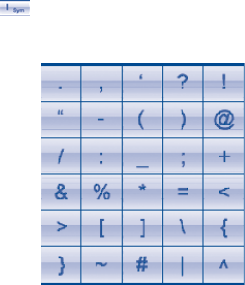
69 70
Symbol table
Short press the
key to display the symbols table; the cursor is positioned in the
centre. Touch and confirm to select.
20 Telephone warranty ..........
Your cellphone is warranted against any defect which may occur in conditions of normal
use during the warranty period of twelve (12) months (1) from the date of purchase as
shown on your original invoice.
Batteries (2) and accessories sold with your cellphone are also warranted against any
defect which may occur during the first six (6) months (2) from the date of purchase as
shown on your original.
In case of any defect of your phone which prevents you from normal use thereof,
you must immediately inform your vendor and present your phone with your original
invoice.
If the defect is confirmed, your phone or part thereof will be either replaced or repaired,
as appropriate. Repaired Phone and accessories are entitled to a one (1) month warranty
for the same defect. Repair or replacement may be carried out using reconditioned
components offering equivalent functionality.
This warranty covers the cost of parts and labor but excludes any other costs.
This warranty shall not apply to defects to your phone and/or accessory due to (without
any limitation):
1) Non-compliance with the instructions for use or installation, or with technical and
safety standards applicable in the geographical area where your phone is used,
2) Connection to any equipment not supplied or not recommended by TCT Mobile
Limited,
(1) The warranty period may vary depending on your country.
(2) The life of a rechargeable cellphone battery in terms of conversation time standby
time, and total service life, will depend on the conditions of use and network
configuration. Batteries being considered expendable supplies, the specifications
state that you should obtain optimal performance for your phone during the first
six months after purchase and for approximately 200 more recharges.
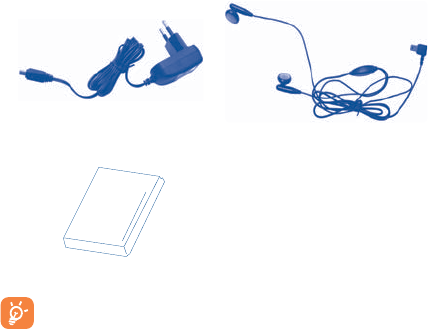
71 72
3) Modification or repair performed by individuals not authorized by TCT Mobile
Limited or its affiliates or your vendor,
4) Inclement weather, lightning, fire, humidity, infiltration of liquids or foods, chemical
products, download of files, crash, high voltage, corrosion, oxidation…
Your phone will not be repaired in case labels or serial numbers (IMEI) have been
removed or altered.
There are no express warranties, whether written, oral or implied, other than this
printed limited warranty or the mandatory warranty provided by your jurisdiction.
In no event shall TCT Mobile Limited or any of its affiliates be liable for incidental or
consequential damages of any nature whatsoever, including but not limited commercial
loss, to the full extent those damages can be disclaimed by law. Some countries/states
do not allow the exclusion or limitation of incidental or consequential damages,
or limitation of the duration of implied warranties, so the preceding limitations or
exclusions may not apply to you.
21 Accessories
(1)
........................
The latest generation of Alcatel GSM cellphones offers a built-in handsfree feature that
allows you to use the telephone from a distance, placed on a table for example. For
those who prefer to keep their conversations confidential, an earpiece is also available
known as the headset.
Only use your telephone with Alcatel batteries, chargers and accessories
compatible with your model.
(1) Pictures for reference only.
Battery
Stereo headset
Standard charger

73 74
22 Troubleshooting ...................
Before contacting the aftersales department, you are advised to follow the instructions
below:
• You are advised to switch off the telephone from time to time to optimize its
performance.
• You are advised to fully charge ( ) the battery for optimal operation.
• Avoid storing large amounts of data in your telephone as this may affect the
performance of your telephone.
and carry out the following checks:
My cellphone will not switch on
• Press until the screen comes on
• Check the battery charge level
• Check the battery contacts, remove and reinstall your battery, then turn your
telephone back on
My phone has not responded for several minutes
• Press the key
• Remove the battery and re-insert it, then switch the phone back on
My screen is difficult to read
• Clean your screen
• Use your cellphone in accordance with the recommended conditions of use
My cellphone turns off by itself
• Check that your Touch Area is locked when you are not using your cellphone
• Check the battery charge level
My cellphone will not charge properly
• Make sure that your battery is not completely discharged; the battery charge indicator
can take several minutes and may be accompanied by a quiet whistling sound
• Make sure charging is carried out under normal conditions (0°C +40°C)
• Make sure your battery is inserted. It must be inserted before plugging in the
charger
• Make sure you are using an Alcatel battery and charger
• When abroad, check that the electrical current is compatible
My cellphone will not connect to a network
• Try connecting in another location
• Verify the network coverage with your operator
• Check with your operator that your SIM card is valid
• Try selecting the available network(s) manually (see page 65)
• Try connecting at a later time if the network is overloaded
SIM card error
• Make sure the SIM card has been correctly inserted (see page 17)
• Verify with your operator that your SIM card is 3V compatible; the old 5V SIM cards
cannot be used
• Make sure the chip on your SIM card is not damaged or scratched
Unable to make outgoing calls
• Make sure you have dialled a valid number and press in dial board
• For international calls, check the country and area codes
• Make sure your cellphone is connected to a network, and that the network is not
overloaded or unavailable
• Check your subscription status with your operator (credit, SIM card valid, etc.)
• Make sure you have not barred outgoing calls (see page 37)

75 76
Unable to receive incoming calls
• Make sure your cellphone is switched on and connected to a network (check for
overloaded or unavailable network)
• Check your subscription status with your operator (credit, SIM card valid, etc.)
• Make sure you have not forwarded incoming calls (see page 38)
• Make sure that you have not barred certain calls
The caller’s name does not appear when a call is received
• Check that you have subscribed to this service with your operator
• Your caller has concealed his/her number
The sound quality of the calls is not optimal
• You can adjust the volume during a call by means of the key
• Check the radio reception icon level
I am unable to use the features described in the manual
• Check with your operator to make sure that your subscription includes this service
• Make sure this feature does not require an Alcatel accessory
When I select a number from my directory, the number is not dialled
• Make sure that you have correctly recorded the number in your file
• Make sure that you have selected the country prefix when calling a foreign country
I am unable to create a file in my directory
• Make sure that your SIM card directory is not full; delete some files or save the files
in the product directory (i.e. your professional or personal directories)
My callers are unable to leave messages on my voicemail
• Contact your network operator to check service availability
I cannot access my voicemail
• Make sure your operator’s voicemail number is correctly entered in “My
Numbers”
• Try later if the network is busy
I am unable to send and receive messages MMS, Vox MMS
• Check your phone memory available as it might be full
• Contact your network operator to check service availability and check MMS parameters
(see page 28)
• Verify the server center number or your MMS profile with your operator
• The server center may be swamped try again later
The icon is displayed on my standby screen
• You have saved too many short messages on your SIM card; delete some of them or
archive them in the product memory
“No service” is displayed
• You are outside of the network coverage area
I have already entered 3 incorrect PIN codes
• Contact your network operator to obtain the PUK code (Personal Unblocking Key)
I am unable to connect my telephone to my computer
• Install first of all Alcatel’s PC suite
• Use “Install the connection” and perform the installation
• Check that your computer meets the requirements for Alcatel’s PC Suite installation
I am unable to download new files
• Check for free space
• Delete some files
• Select the MicroSD Card to store the files you downloaded
• Check your subscription status with your operator
The phone can’t be detected by others via Bluetooth
• Make sure that Bluetooth is turned on and your cellphone is visible to other users (see
page 56)
My cellphone is dead, can’t power on
• Make sure your battery is not completely used up or damaged.
• Remove your battery, remove your SIM card then power it on again.
•
Hold down
key + answer on/off key at same time, then press up
key to reset it. (1)
(1) ALL User phone data: contacts, photos, messages, files and downloaded applications
such as Java games will be lost permanently.

77 78
ALCATEL is a trademark of Alcatel-Lucent
and used under license by
TCT Mobile Limited.
All rights reserved © Copyright 2009
TCT Mobile Limited.
TCT Mobile Limited reserves
the right to alter material or technical
specification without prior notice.
English: CJA20K1ALAAA
My touch Lens doesn’t work
• Access to profile by long press power key, then long press up volume key to access
LCD calibration and down volume key to access LED calibration.
How to make your battery last longer
• Make sure you followed the complete charge time (minimum 3 hours)
• After a partial charge, the battery level indicator may not be exact. Wait for at least
20 minutes after removing the charger to obtain an exact indication
• Switch on the backlight upon request.
• Extend email auto-check interval as long as possible.
• Update news, weather info. upon demand manually or set its auto-check interval
longer.
• Exit Java background-running applications if they are not being used for a long time.
• Deactivate Bluethooth when not in use.